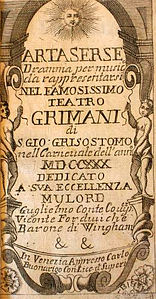Artaserse (Hasse)
| Work data | |
|---|---|
| Title: | Artaserse |

Title page of the 1730 libretto |
|
| Shape: | Opera seria |
| Original language: | Italian |
| Music: | Johann Adolph Hasse |
| Libretto : | Pietro Metastasio |
| Premiere: | February 11, 1730 |
| Place of premiere: | Teatro San Giovanni Grisostomo , Venice |
| Playing time: | about 3 hours |
| Place and time of the action: | Susa , capital of the Persian Empire , 465 BC Chr. |
| people | |
|
|
Artaserse is an opera seria in three acts by the composer Johann Adolph Hasse based on the libretto Artaserse by Pietro Metastasio . Artaserse is the Italian form of the name of the Persian great king Artaxerxes I.
Plot and libretto
Work history
The premiere took place on February 11, 1730 in the Teatro San Giovanni Grisostomo in Venice. The male lead of Prince Arbace was sung by the famous castrato Farinelli . The other performers were Filippo Giorgi (Artaserse), Francesca Cuzzoni (Mandane), Nicolò Grimaldi (Artabano), Maria Maddalena Pieri (Semira) and Castore Antonio Castori (Megabise).
Many other performances followed in other Italian cities, including that of a revised version in 1734 at the Teatro San Giovanni Crisostomo in Venice. In April 1738 the opera was performed in the Theater am Tummelplatz in Graz (German by FJ Pircker), 1738 in Madrid , 1740 in Ljubljana . On September 9, 1740, Hasse reworked it for the court theater in Dresden . A largely new setting, in which only a few of the old arias were preserved, was performed on January 20, 1760 at the Teatro San Carlo in Naples. This was played on August 3, 1760 in the Royal Polish Opera House in Warsaw .
On October 29, 1734, Artaserse was performed in London by the Opera of the Nobility , which was competing with Handel's opera company, as a pasticcio , that is, partly with music by other composers, in this case by Attilio Ariosti , Nicola Antonio Porpora and Farinelli's brother Riccardo Broschi . The title page of the libretto and some other sources name the King's Theater on Haymarket as the venue .
In 1748 the opera was performed on the occasion of the opening of the Margravial Opera House in Bayreuth.
Recordings and performances in recent times
- 1999: Performance at the Teatro Rossini, Lugo. Orchestra Sinfonica dell'Emilia-Romagna, conductor: Rinaldo Alessandrini . Singers: Paoletta Marrocu (Mandane), Patrizia Bicciré (Arbace), Emanuele Giannino (Artabano), Maria José Trullu (Artaserse), Giovanna Donadini (Megabise), Anna Burford (Semira).
- 2009: Performance of the 1730 version at St. Giles Church, London. Ensemble Serse. Singers: Julian Forbes (Artaserse), Sarah Moule (Mandane), Oliver Gerrish (Artabano), Calvin Wells (Arbace), Katherine Cooper (Semira), Melanie Sanders (Megabise).
- 2012: CD and DVD recording of a performance in the Palazzo Ducale in Martina Franca . Ensemble Barocco dell'Orchestra Internazionale d'Italia, conductor: Corrado Rovaris. Singers: Anicio Zorzi Giustiniani (Artaserse), Maria Grazia Schiavo (Mandane), Sonia Prina (Artabano), Franco Fagioli (Arbace), Rosa Bove (Semira), Antonio Giovannini (Megabise).
- April 12, 2018: Performance for the reopening of the Margravial Opera House in Bayreuth. Hofkapelle Munich , conductor: Michael Hofstetter , director: Balázs Kovalik. Students of the August Everding Theater Academy , Kathrin Zukowski (Friedrich), Natalya Boeva (mother), Anja Silja (Margravine Wilhelmine, speaking role). A heavily edited pasticcio version was played, which referred to Wilhelmine's life and into which an aria from her opera Argenore and excerpts from Hasse's opera Ezio were incorporated.
- 2018: Performance of the Pinchgut Opera, Sydney. Orchestra of the Antipodes, conductors: Erin Helyard , Chas Rader-Shieber (direction), Charles Davis (costumes). Singers: Vivicagenaux (Mandane), David Hansen (Arbace), Carlo Vistoli (Artabano), Andrew Goodwin (Artaserse), Russell Harcourt (Megabise), Emily Edmonds (Semira).
Web links
- Artaserse : Sheet music and audio files in the International Music Score Library Project
- Libretto (Italian / German), Dresden 1740. Digitized version of the Munich digitization center
Individual evidence
- ↑ a b c Artaserse (Johann Adolf Hasse) in the Corago information system of the University of Bologna , accessed on August 2, 2016.
- ↑ Roland Dieter Schmidt-Hensel: “La musica è del Signor Hasse detto il Sassone…” Johann Adolf Hasse's “Opere serie” from 1730 to 1745. Sources, versions, performances. Part I: Representation. V&R unipress 2009, ISBN 978-3-89971-441-8 , v. a. Pp. 92, 95 and 226.
- ↑ a b c d Artaserse (Johann Adolf Hasse) at operabaroque.fr , accessed on August 2, 2016.
- ^ Paul Henry Lang: George Frideric Handel. Courier Corporation, 2012, p. 250 ( limited preview in Google Book search).
- ^ Raise the curtain in the Margravial Opera House in: Nordbayerischer Kurier from April 11, 2018, p. 16.
- ^ Peter Jungblut: Wilhelmines margravial dog life. In: BR-Klassik , April 13, 2018, accessed on April 13, 2018.
- ↑ Stephan Mösch : With the courage to open the gap. In: Opernwelt , June 2018.
- ^ Sandra Bowdler: Hasse's Artaserse receives its Australian première. Review of the performance of the Pinchgut Opera 2018 on bachtrack.com, December 1, 2018, accessed on January 14, 2019.